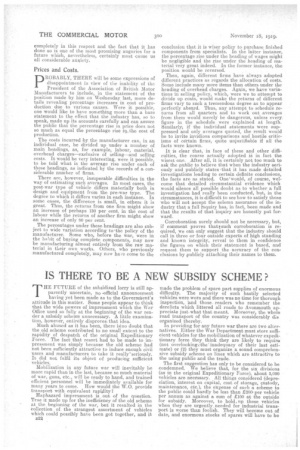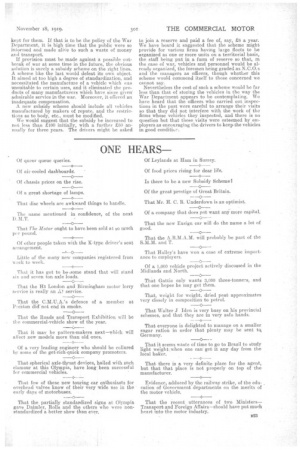IS THERE TO BE A NEW SUBSIDY SCHEME?
Page 2

Page 3

If you've noticed an error in this article please click here to report it so we can fix it.
THE FUTURE of the subsidized lorry is still apparently uncertain, no -official announcement having yet been made as to the Governthent's attitude in this matter. Some people appear to think that the wide powers of impressment which the War Office used so fully at the beginning of the war render a subsidy scheme unnecessary. A little examination, however, entirely disproves,that idea..
Much abused as it has been, there iAno doubt that the old scheme contributed to no small extent to the rapidity of despatch of the original Expeditionary Force. The fact that resort had to be made to impressment was simply because the old scheme had not been sufficiently attractive to induce enough civil users and manufacturers to take it really'seriously. It did not fulfil its object of producing sufficient vehicles.
Mobilization in any future war will inevitably be more rapid than in the last, because so much material of war, guns, etc., will be ready to hand, and trained efficient personnel will be immediately available for many years to come. How would the W.O. provide transport with equivalent rapidity ?
Haphazard impressment is out of the question. True it made up for the inefficiency of the old scheme at the beginning of the war, but it resulted in the collection of the strangest assortment of vehicles which could possibly have been got together, and it
B22 . made the problem of spare part supplies of enormous difficulty. The majority of such hastily selected vehicles were worn and there was no time for thorough inspection, 'and those. readers who remember the derelicts which littered all roads to Avonmouth appreciate just.what that meant. Moreover, the whole road transport of the country was considerably dia organized thereby.
In providing for any future war there are two alternatives. Either the War Department must store sufficient vehicles for the mobilization of whatever expeditionary force they think they are likely to require (not overlookingthe' inadequacy of their last estimate) or (2) they must organize a soundcomprehensive subsidy scheme on lines which are attractive to the using public and the trade.
The first suggestion has only to be considered to be condemned. We believe that, for the six divisions (as in the original Expeditionary Force), about 3,000 vehicles are necessary. All things considered (depreciation, interest on capital, cost. of storage, custody, maintenance, etc.), the expense of such a scheme to the public could hardly be less than 2200. per vehicle per annum as against a sum of 2100 at the outside for subsidy. Moreover, to hold, up these vehicles when they are urgently. needed for industrial transport is worse than foolish. They will become out of date, and enormous stocks of spares will have to be kept. for them. If that is to be the policy of the War Department, it is high time that the public were so informed and made aliVe to such a waste of money and transport.
If provision must be made against a possible outbreak of war at some time in the future, the obvious solution is surely a subsidy scheme on the right lines. A scheme like the last would defeat its own object. It aimed at too high a degree of standardization, and necessitated the manufacture of a vehicle which ;vas unsuitable to certain uses, and it eliminated the products of many manufacturers which have since given' admirable service in the war. Moreover, it offered an inadequate compensation.
A new subsidy scheme should include all vehicles manufactured by makers of repute, and the restrictions as to body, etc., must be modified.
We would suggest that the subsidy be increased to not less than £100 initially, with a further £50 annually for three years. The drivers might be asked to join a reserve and paid a fee of, say, £8 a year. We have heard it suggested that the scheme might provide for various firms having large fleets to be organized as one or more units on a territorial basis, the staff being put in a form of reserve so that, in the case of war, vehicles and personnel would be already organized, the foremen being graded as N.C.O.s and the managers as officers, though whether this scheme would commend itself to those concerned we cannot say, Nevertheless the cost of such a scheme would be far less than that of staring the vehicleS in the way the War Department appears to be contemplating. We have heard that the officers who carried out inspections in the past were careful to arrange their visits so that they did not interfere with the work of the firms whose. vehicles they inspected, and there is no question but that these visits were esteemed by employers as encouraging the drivers to keep the vehicles in good conditior:




























